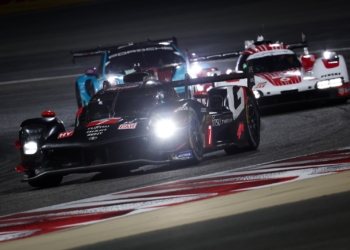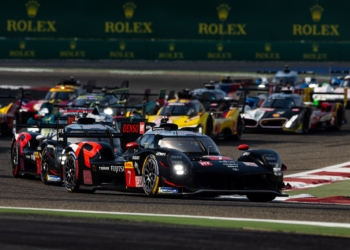The #7 Toyota crew of Nyck de Vries, Mike Conway and Kamui Kobayashi have won the FIA World Endurance Championship’s 8 Hours of Bahrain, the season-closing race.
This ensures that Toyota don’t have their first winless WEC season since 2015. It also continues Toyota’s run of victories at Bahrain, with de Vries crossing the line to take the Japanese manufacturer’s eighth consecutive win at Bahrain in WEC.
The sister #8 Toyota of Sebastien Buemi, Ryo Hirakawa, and Brendon Hartley finished second, with Buemi 17 seconds off de Vries at the end of the race.
Nicklas Nielsen finished third in the #50 Ferrari. This ensured Ferrari won the manufacturers’ world title, which has been an aim of Ferrari’s since the start of the year.
Alessandro Pier Guidi finished fourth in the #51 Ferrari. However, the more significant result for the Italian and his teammates, James Calado and Antonio Giovinazzi, is winning the drivers’ world championship, their first in the Hypercar era.
Ferrari switched the position of the two with a few minutes remaining, to make sure Ferrari took a 1-2-3 finish in the drivers’ championship. The #50 finished the season third in the points standings, but were beaten by their teammates in the privately-run satellite entry, the #83 AF Corse Ferrari.
Robert Kubica took the yellow Ferrari across the line to finish fifth, alongside his teammates Yifei Ye and Phil Hanson. They were in the hunt for the championship victory but were unable to beat the #51 crew in the end, finishing second in the standings.
Toyota control race from start
The race began with Conway starting from pole in the #7 Toyota. He and teammate Hartley ran line of stern for the first hour of the race, with the #945 Peugeot of Loic Duval third a few seconds back.
At the first round of pitstops, Hartley did not get new rubber on his #8 Toyota, while Conway did, in a strategy pre-planned before the race. This meant the #8 Toyota would be guaranteed new tyres for the end of the race – a significant advantage at Bahrain, notorious for high tyre wear.
This meant Hartley took the lead as his stop was faster. However, he soon dropped back as the rubber began to degrade, behind #51 Ferrari’s Giovinazzi.
Giovinazzi had started seventh and moved quickly up the order and had passed Duval for third, then moved past a struggling Hartley.
The stint continued in this fashion with no major movement, until Conway pitted to hand over to De Vries, still leading the race. Buemi had replaced Hartley, who now had new tyres on the #8, and took second back off the #51 Ferrari, now driven by Alessandro Pier Guidi.
Virtual safety car shakes things up
In the fourth hour of the race, however, a virtual safety car was called for a heavy crash for the #54 AF Corse Ferrari 296 GT3’s Thomas Flohr, who had gone hard into the barriers after turn 3.
The bronze-rated driver had, it turns out, been punted by Jenson Button in the #38 Cadillac, in the Briton’s final race as a professional racing driver.
Button was battling with Sheldon van der Linde, in the #20 BMW. With Flohr ahead, Button went left after exiting turn 3, on the straight run to turn 4. S. van der Linde went right, with Flohr in between, but got punted by the Cadillac as Button battled for position.
The Hypercars pitted en-masse , with the pit lane remaining open under VSC. They were then regrouped in order behind the resulting full safety car, with de Vries leading from Buemi, Pier Guidi, Jean-Eric Vergne in the #93 Peugeot, and Alex Riberas in the #009 Aston Martin Valkyrie in fifth.
Riberas takes lead in Valkyrie
While the drivers ahead hadn’t changed tyres at the stop under VSC, Riberas had. This gave him a considerable advantage, with the Spaniard using it to full effect to take the lead from de Vries in just a matter of laps. This marked the first time Aston Martin had led an overall WEC race in the Hypercar era, and meant all eight manufacturers led at least a lap over the season.
Riberas created an 11 second gap to de Vries on his new tyres, but then disaster: he received a drive through penalty for a procedural error under VSC.
He subsequently pitted and lost 28 seconds driving through the pitlane, emerging fifth behind teammate Ross Gunn in the sister #007 car.
Soon after, de Vries, now back in the lead, made a scheduled stop, handing the car to teammate – and Toyota team principal – Kamui Kobayashi.
The pitstops put WEC debutant, and full time driver next year for Peugeot, Theo Pourchaire, into the lead. The Frenchman, in the #94 Peugeot, led for some laps but was passed before he stopped by Kobayashi, who now had a pitstop gap to the French car.
Meanwhile, Ryo Hirakawa, in the #8 Toyota and was running second when the order sorted itself out after the pitstops, had to pit for a drive through penalty, for overtaking under yellow flags. This would drop the Japanese driver the ninth and may have cost them the win – a costly error.
De Vries, Kobayashi, and Conway win race for Toyota
Kobayashi and his #7 Toyota teammates, then, looked to be in the driving seat for the win. He led the race until he handed the car back over to de Vries for the final double stint of the race.
De Vries wasn’t challenged from then on, although he had to survive a race restart after another VSC and safety car period was required, due to Dries Vanthoor, in the #15 BMW, suffering a suspension failure, spinning at turn 11 and unable to move.
De Vries, though, was unfazed. He finished 19.3 seconds ahead of Buemi in the sister #8 Toyota, a controlled 1-2 for the Japanese manufacturer, who were at times put under pressure from the Ferraris.
Nicklas Nielsen took third in the #50 Ferrari. It wasn’t an easy race for Ferrari, having to bounce back after a mediocre qualifying, with the #50 starting 11th.
Jakobsen, Fuoco, Hirakawa squabble for position
But they made it through the field, and in the final hours of the race Nielsen’s teammate Fuoco was engaged in a magnificent fight with Malthe Jakobsen in the #94 Peugeot. The two were squabbling over third, with the Peugeot, defending the position, enjoying superior straight line speed, while the Ferrari had more pace in the corners.
Due to these differences in how the cars were making lap time, it took some laps for Fuoco to find a way by. A few times he passed the Danish driver, only to see the Peugeot sweeping back past, using that impressive speed in a straight line.
The Italian finally sealed the move at turn 4. This then opened the door to Hirakawa, climbing back through the field after the penalty. He too had trouble getting past the young Peugeot racer, who was defending excellently from drivers much older and more experienced than himself.
The Toyota, though, made the move stick at turn 4, just like Fuoco, and that was that.
Alessandro Pier Guidi finished fourth in the #51 Ferrari, taking the coveted drivers’ title as well, alongside Calado and Giovinazzi. To ensure a 1-2-3 finish in the drivers’ championship standings, Ferrari switched the cars with a few minutes to go. This meant the #51 crew wouldn’t get to celebrate their title win on the podium – a fact that Toyota were probably glad about.
Fifth was the yellow Le Mans-winning #83 AF Corse Ferrari of Robert Kubica, alongside Yifei Ye and Phil Hanson. The trio had pace but were never quite as quick as the two factory Ferraris ahead of them, taking the runners-up spot in the drivers’ championship.
#87 ASP Lexus wins LMGT3
Over in LMGT3, the race was won by Jose Maria Lopez, Petru Umbrarescu, and Clemens Schmid in the #87 ASP Lexus.
Umbrarescu started the race fourth, but the Lexus had pace all race at Bahrain, and it didn’t take long at all for the #87 car to take the lead, with Schmid at the wheel, shortly after the first round of stops.
It was a lead they very rarely relinquished, a dominant win for the Akkodis ASP Lexus team.
The pole-sitting car, the sister #78 ASP Lexus, had Arnold Robin in at the start. He led the first hour of the race but, mid way into the car’s second stint, had to pit with mechanical problems. The engineers proceeded to disassemble the car but it was clear it was a major issue, and it wasn’t seen in the race again.
Second was the #61 Iron Lynx Mercedes-AMG crew of Maxime Martin, Martin Berry and Lin Hodenius. Berry started the car third but was soon up into second after passing teammate in the sister #60 car, Andrew Gilbert. From there they ran in the top positions of the class all race, to finish second after eight hours.
Third was Mattia Drudi, Ian James and Zacharie Robichon in the #27 Heart of Racing Aston Martin, who’d started sixth and raced well to come home third.










Discussion about this post